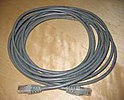Twisted pair: Difference between revisions
Propose merging from Foiled Twisted Pair article, and reformatted the FTP section. |
Reorgnized, reformatted. |
||
| Line 12: | Line 12: | ||
:''Main article please see [[Electromagnetic shielding]].'' |
:''Main article please see [[Electromagnetic shielding]].'' |
||
Twisted pair cables are often shielded to prevent [[electromagnetic interference]]. Because the shielding is made of metal, it also serves as a ground. |
Twisted pair cables are often shielded to prevent [[electromagnetic interference]]. Because the shielding is made of metal, it also serves as a ground. This shielding can be applied to individual pairs, or to the collection of pairs. When shielding is applied to the collection of pairs, this is referred to as screening. |
||
=== |
===Unshielded Twisted Pair (UTP)=== |
||
{|style="width:100% |
{|style="width:100%" |
||
|-style="vertical-align:top" |
|-style="vertical-align:top" |
||
|[[image:UTP-cable.png|thumb|150px|right|Unshielded Twisted Pair]]{{mergefrom|Unshielded twisted pair}}UTP cables are not shielded. This lack of shielding results in a high degree of flexibility as well as rugged durability. UTP cables are found in many [[ethernet]] networks and telephone systems. |
|||
| ⚫ | |||
| ⚫ | |||
|[[image:STP-cable.png|thumb|150px|right|Shielded Twisted Pair]] |
|||
| ⚫ | |||
| ⚫ | |||
| ⚫ | |||
| ⚫ | |||
|} |
|} |
||
| Line 28: | Line 33: | ||
|} |
|} |
||
===Unshielded Twisted Pair (UTP)=== |
===Screened Unshielded Twisted Pair (S/UTP)=== |
||
{|style="width:100% |
{|style="width:100%" |
||
|-style="vertical-align:top" |
|-style="vertical-align:top" |
||
|{{mergefrom| |
|{{mergefrom|Foiled twisted pair}}S/UTP, also known as Fully-shielded Twisted Pair (FTP) and Screened Fully-ahielded Twisted Pair (S/FTP), is a screened UTP cable. |
||
|[[image:UTP-cable.png|thumb|150px|right|Unshielded Twisted Pair]] |
|||
| ⚫ | |||
| ⚫ | |||
| ⚫ | |||
| ⚫ | |||
|{{mergefrom|Foiled twisted pair}} <p>FTP cable is basically a UTP cable surrounded by an outer foil shield increasing protection from external interference.</p> |
|||
|[[image:S-UTP-cable.png|thumb|150px|right|Screened Unshielded Twisted Pair, Foiled Twisted Pair, Screened Foiled Twisted Pair]] |
|[[image:S-UTP-cable.png|thumb|150px|right|Screened Unshielded Twisted Pair, Foiled Twisted Pair, Screened Foiled Twisted Pair]] |
||
|} |
|} |
||
==Cable Categories== |
|||
===Screened Unshielded Twisted Pair (S/UTP)=== |
|||
| ⚫ | |||
The same as FTP but with a braided shield instead of foil. |
|||
==Uses== |
|||
===Screened Foiled Twisted Pair (S/FTP)=== |
|||
This is a combination of S/UTP and FTP i.e. with a combined braided and foil shielding. |
|||
<br style="clear: both;" /> |
|||
| ⚫ | |||
In telephone applications, UTP is often grouped into sets of 25 pairs according to a standard [[25-pair color code]] originally developed by [[AT&T]]. A typical subset of these colors (white/blue, blue/white, white/orange, orange/white) shows up in most UTP cables. |
In telephone applications, UTP is often grouped into sets of 25 pairs according to a standard [[25-pair color code]] originally developed by [[AT&T]]. A typical subset of these colors (white/blue, blue/white, white/orange, orange/white) shows up in most UTP cables. |
||
Revision as of 02:19, 28 May 2006


Twisted pair cabling is a common form of wiring in which two conductors are wound around each other for the purposes of canceling out electromagnetic interference which can cause crosstalk. The number of twists per meter makes up part of the specification for a given type of cable. The greater the number of twists, the more crosstalk is reduced. Twisting wires decreases interference because:
- The loop area between the wires (which determines the magnetic coupling into the signal) is reduced as much as physically possible.
- The direction of current generated by a uniform coupled magnetic field is reversed by every twist, so that the currents in successive twists cancel each other.
Cable Shielding
- Main article please see Electromagnetic shielding.
Twisted pair cables are often shielded to prevent electromagnetic interference. Because the shielding is made of metal, it also serves as a ground. This shielding can be applied to individual pairs, or to the collection of pairs. When shielding is applied to the collection of pairs, this is referred to as screening.
Unshielded Twisted Pair (UTP)
 |
Shielded Twisted Pair (STP)
 |
Screened Shielded Twisted Pair (S/STP)
Screened Unshielded Twisted Pair (S/UTP)
Cable Categories
Twisted pair cabling is standardized into various categories by number, which indicate signal integrity attributes. Category 5 cable is commonly used for Ethernet with 10BASE-T or 100BASE-TX.
Uses
In telephone applications, UTP is often grouped into sets of 25 pairs according to a standard 25-pair color code originally developed by AT&T. A typical subset of these colors (white/blue, blue/white, white/orange, orange/white) shows up in most UTP cables.


